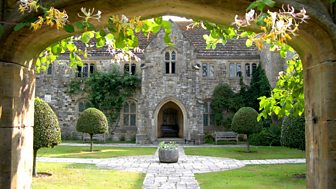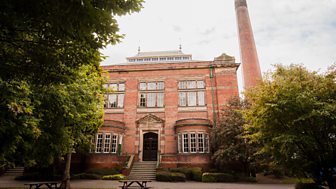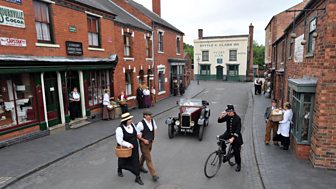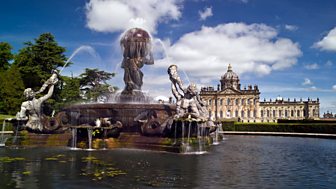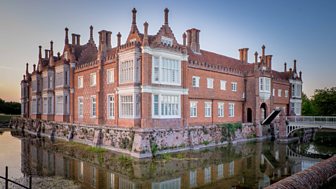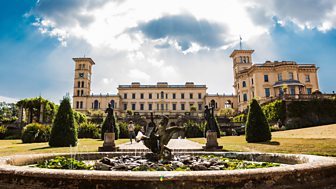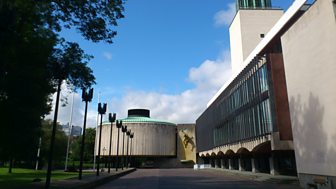 During
the Second World War it had become apparent, as early as 1941, that
the German U-Boats patrolling the Atlantic were sinking so much of
Britain's essential materials that it was difficult to supply the
country.
During
the Second World War it had become apparent, as early as 1941, that
the German U-Boats patrolling the Atlantic were sinking so much of
Britain's essential materials that it was difficult to supply the
country.
Even before the war, Britain was never self sufficient in
its need for raw materials, such as timber and had a severe lack of
indigenous timber
suitable
for furniture making.
Yet
there was still increased demand for new furniture due to the losses
caused by bombing and to the continuing establishment of new
households after marriage.
And of course increased war production.
The
Utility Furniture Advisory Committee was set up in 1942,
drawing on considerable expertise.
Gordon
Russell,
Ernest
Clench,
Herman Lebus
and
John
Gloag
were brought in because of their experience, to
assure that these scarce available
resources were used in a sensible way.
Rationing
of new furniture was restricted to newly-weds and people who had been
bombed out, under the "Domestic Furniture (Control of
Manufacture and Supply (No 2)) Order 1942" which became
operative from 1 November 1942.
The
aim was to ensure the production of strong well-designed furniture
making the most efficient use of the recsource of timber available.
The
Committee were reconstituted as the Utility Design
Panel in 1943 with
Gordon Russell as Chairman.
The furniture, made during the war, featured a 'CC'
symbol.
The
symbol was designed by Reginald Shipp.
The motif is known
as two cheeses.
Along with the two cheeses there should also be
number
indicating the year so CC41 stands for 'Controlled
Commodity 1941'.
It
appeared on all sorts of items, furniture, linen,
clothes and many other domestic items.
The
Committee produced a number of approved
designs, many were published
in the Utility Furniture
Catalogue of
1943.
Post War
After the second world war the
Board of Trade
took control of furniture production.
They
regulated the industry and set out to control manufacture, by law,
controlling the use and movement of all materials
Strict
specifications were laid down and the Utility Furniture scheme was
used to assist production. Or so it was claimed.
Licenses
were issued and quite a lot of these were given to companies already
in the manufacture of aircraft, and other war supplies.
These
companies, it was thought, were able to make furniture in a form of
construction that could make light furniture with the use of plywood.
The
control of design through meticulous attention to production
encompassing good design was laid down through a technical framework.
1945
saw the Directorate of Furniture production transformed.
This
became the headquarters of the British Furniture Industry.
Five
different sections were divided into the design section.
The
Technical section.
A
planning section.
A
licensing section.
A
material issue section.
The
design section.
The
Utility stamp was brought in as the abolition of priority cases gave
way to the needs of the entire community.
This
administration of material was used to control the entire
manufacturing process until 1948 when this was revoked and a licence
was granted to enable the Utility marks to be used generally.
This
in theory stopped the government control.
But in practice raw
materials were still given in precedence to those producing for the
Utility scheme.
 Gradually
they would be able to place the mark on their own designs.
Gradually
they would be able to place the mark on their own designs.
The
categorisation of articles had to continue and goods sold under a
appropriate maximun price.
In
1946, in conjunction with the important exhibition of post-war
design, "Britain
Can Make It",
three new furniture ranges were unveiled (Cotswold, Chiltern and
Cockaigne) intended to carry forward the best of their design ethos
into the postwar period.
As the names suggests it was a
style that was
looking back to the past more in line with Arts
and Crafts.
The
general public had less money to spend so it became a buyers market.
Slowly the furniture industry would return to a normal community.
The
theory was that, if efficient companies were chosen to manufacture
from the start there may have been less waste.
But it was thought
that this would have been market manipulation and stifle the
fledgling industry.
It
is hard to envisage today that it was a offence punishable by
imprisonment for any company to make a single stick of furniture.
This constriction continued for three or four years after the war.
Many
with licenses were not the best of manufacturers.
And
the old boy network surely came into play.
Buying
of timber was forbidden, by law. There was a rationing of timber, and
it was also an offence to consume pre-war stock. That's was if it was
not requesitioned.
The
government control in effect created a black market.
During
the war there were only 137 licensed furniture manufacturers in 1943.
This
rose to 450 in 1945 out of a total of 4000 companies.
The remainder
were treated as if they did not exist.
A
license was required for the manufacture of a coffee table, and this
may be given, provided the timber content did not exceed a fraction
of a cubic foot. And all calculations were laid down.
Off cuts
and stubs had to come from elsewhere as companies could not use their
own.
To make things worse the license could be refused to obtain
these off cuts
Purchase
tax rose from 33% to over 66% rendering the tables and other pieces
virtually unsaleable.
Even if you were lucky enough to pull all the right strings and get
it made you would have to be extremely lucky to sell the damn things.
As
an example David Joel released from the Navy wanted to get going. His
factory had been let for the production of aeroplanes and then sold
to a cosmetics company but he had some land at the back of his old
workshops that he acquired.
He
then had a factory without labour. Then he acquired machinery and was
given a list by the Board of Trade of what was needed. These amounted
to Fancy goods and Domestic equipment in reality, Ironing boards,
rolling pins, blinds, cards and trays.
When
a lady from the government turned up he struck up a relationship with
her.
She
had been a milliner near his Knightsbridge showroom. “neighbourly
feelings prevailed and I got my Timber” he was quoted as saying.
It's
not what you know of course.
Stafford
Cripps had set up a working party in 1945 for the furniture trade.
They had constructed bodies for the nationalization but when the
government imposed a purchase tax it killed it stone dead.
War
kept its grip for a long time after cestation and it was said a
malaise crept in.
To
make things worse the national stock pile of timber was piled in the
open air but still existed in huge quantities in 1951 but the
deteriation due to the lack of care led to most of it being
worthless.
The
mositure content was left uncontrolled while bureaucracy took place
and those in the scheme did alright but numerous craftsmen had to
change trade through no fault of their own.
This
would add another factor to the industry getting back on its feet.
Up
until as late as 1948 the supply of Utility furniture was restricted
to priority cases.
The
intended 'setting free of design' came about but it still took three
months of bureaucracy to be able to apply for a license to be able to
apply the utility mark.
There
was a market for reproduction style furniture and the Utility scheme
seemed hardly worth its bulk through design.
The
task of creating ingenious design hardly seemed worth it for many
companies struggling enough and wanting to, just get on with honest
work of giving the public what they wanted.
There was a black
market with carvings added making the design more appropriate and
easier for the public to accept.
The
cost of shipping and crating was prohibitive to its manufacture.
Still
the Development council was engaged in performance tests.
Chairs had
to pass breaking tests along with others. It was all very well to
design wear tests but if the timber used was not the right moisture
content then it seems pointless.
A
chair could withstand any test at manufacture but if it is not
properly seasoned it may well fall to pieces in a couple of weeks.
The quality it seems had been taken away from the people who
understood the task in hand, the craftsmen.
Scandinavian
design was held in regard and was possibly a major influence on the
post war design. Though it now seems apparent that design was indeed
led by cost and the Scandinavian style was not as thick and heavy as
the Arts and Crafts inheritance that was prevalent before war broke
out.
The
scheme was officially closed in 1952, the same year that furniture
rationing ceased.
Heals
produced Utility furniture as did Gordon Russell.

